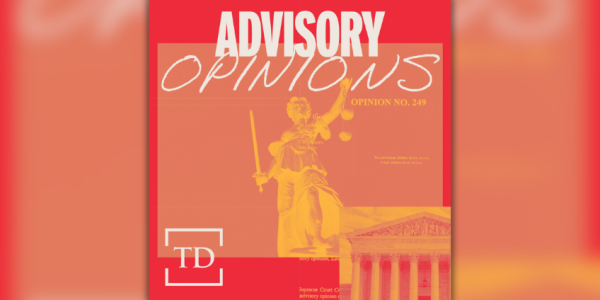Since March 24, when Michigan Gov. Gretchen Whitmer first issued a stay-at-home order, one word has come up again and again: science. She has defended both mundane and controversial elements of her various executive orders as being “informed by the best science” and relying on “a data-driven approach based on facts, based on science.”
Using epidemiological medical science and data is crucial in aiding the political decisions required by a global pandemic. However, it’s important to note the downside of relying on science alone in making these decisions.
During the press conference announcing the stay-at-home order, Whitmer justified the decision based on a model that predicted up to 7 million COVID-19 infections and 1 million hospitalizations in the state of Michigan alone. Attempting to assuage fears, she said that the order would be temporary “to buy time so we can create surge capacity in our hospitals.”
Despite these initial claims, the order continued, even as hospitals throughout Michigan remained below peak occupancy, with major hospital systems laying off thousands of workers, partially due to another executive order prohibiting non-essential medical procedures.
Whitmer has even cited science in resisting attempts by the Michigan State Legislature to limit her executive authority. Whitmer’s press secretary Tiffany Brown describes her ongoing power struggle with Republican legislators as “based on science and data, not political or legal pressure.”
As demonstrators in Lansing protested her stay-at-home orders in April and May, she decried them as dangerous, saying after one that “I was really disappointed to see people congregating and not wearing masks. … This kind of activity will put more people at risk and, sadly, it could prolong the amount of time that we have to be in this posture.”
She echoed these comments in a later appearance on The View, saying, “They are congregating, they are not wearing masks, they are not staying six feet apart, and then they go back home into communities. …While I respect people’s right to dissent, they need to do it in a way that is responsible and does not put others at risk.”
And yet, Whitmer participated in a civil rights march in Detroit last week, wearing a mask but not practicing social distancing. In defending her participation, Whitmer mentioned neither science nor data, instead noting that “I thought that it was an important moment to show my support and show a unified leadership out of the executive office of the governor.”
Whitmer’s decision to ignore her own social distancing mandates is merely the latest sign that her administration’s response to COVID-19 has been arbitrary, opaque, and at times, deadly.
For example, Michigan Executive Order 2020-42 (now rescinded) required large retailers to cordon off sections of stores selling carpet, furniture, paint, and garden products and prohibit their sale, even as the rest of the store remained open. The same order prohibited Michiganders from using motorboats—though they were free to use canoes, kayaks, and sailboats. Lastly, 2020-42 also prohibited “travel between two residences,” a practice common in the state dotted with 11,000 lakes that are surrounded by cabins and cottages..
There’s a certain logic to the order. In most cases, purchasing paint, driving a boat, or traveling to a vacation home isn’t “necessary.” However, the restrictions on commerce and basic human liberty seemed to be based on arbitrary dictates and not, as Whitmer claimed, in public health, science, and data. There is no scientific reason why going to a big box store to to buy a new desk for working remotely was a significantly greater public health risk than going to the same store to buy food.
What was perhaps her most problematic decision was Michigan Executive Order 2020-50, issued on April 15 and since rescinded, which set up a system for long-term care facilities to accept residents affected by COVID-19 when discharged from hospitals. Since then, somewhere between 1,505 and 2,297 nursing home residents have died from COVID-19 in Michigan. accounting for up to 40 percent of the state’s death toll, which presently is near 6,000.
When pressed on this decision in a recent hearing in the U.S. House of Representatives, Whitmer doubled down on scientism, saying, “We recognize that, of course, in retrospect, probably a number of decisions we would have made some adjustment in,” while further noting that “We were working with the best counsel of our public health experts” in making the decision. In Whitmer’s mind, it wasn’t a mistake at the time—they were just looking at science.
This all presents a stark demonstration of the danger of basing all political and economic decisions on poorly defined “science,” particularly when they are wide-reaching, immediate, and subject to overnight change based on executive discretion. Given the relatively recent emergence of COVID-19, the scientific understanding of the virus is constantly changing, as is the quality and type of data that governments have access to.
In light of an unprecedented and continually evolving situation, the state’s response should be measured and reflect this imperfect knowledge. Instead, Whitmer’s response implied that the science was settled, and every move was both justified and necessary to save lives.
In his 1952 book The Counter-Revolution of Science, Austrian economist F.A Hayek wrote on the long-term consequences of scientism, which he defined as the “slavish imitation of the method and language of Science.” Hayek argued that, as scientific understanding continued to grow, many would substitute the difficult work of understanding the limits of human reason for an uncompromising devotion to science.
He does not reject science, or its utility, but notes that hard sciences do not in themselves have all the answers. For example, epidemiology can tell you how a virus spreads, but economics can tell you how people actually act and behave in response to a stay-at-home order.
Hayek further argued the logical consequence of scientism was “conscious direction of all forces of society.” As he writes: “The collectivist method … bases its demands for conscious control on the assumption that it can comprehend the process as a whole and make use of all knowledge in a systematically integrated form. It thus leads directly to political collectivism.”
Given her stated commitment to science, Whitmer has been surprisingly reticent to share the metrics and numbers that her administration is using to determine when to relax and adjust the stay-at-home orders.
When pushed to reveal the metrics and data that were being used to evaluate reopening Michigan, Whitmer said “There’s no special formula that will tell us how and when to reopen,” and that “There’s no textbook specific number that will tell you it is safe to reengage a particular sector of the economy.” Why is there a higher threshold for the science and data required to reopen Michigan than there was to shutter it in the first place? She has no answer.
Perhaps she hopes the issue will be forgotten, as more and more of Michigan is beginning to gradually reopen. Even as the economic consequences of the shutdown become clear, including predictions for significant budget shortfalls at the state level, Whitmer is likely to continue the narrative that it was all necessary and proper, regardless of the cost.
Arbitrary and sweeping executive orders, rescinded in a matter of weeks? Necessary. Millions of Michiganders unemployed with a system unable to handle the strain? Necessary. The deaths of thousands in Michigan’s nursing homes as a direct result of her own policies? Necessary.
This is the ultimate result of scientism. When political decisions are vested in one office, unmoored from principles, and rest solely on humanity’s limited scientific understanding, there is no longer any accountability for error. After all, it was all necessary—just check the science and the data.
Tyler Groenendal is the director of foundation relations at the Fund for American Studies. He previously worked for the Acton Institute for the Study of Religion and Liberty.
Photograph by Photo by Jeff Kowalsky/AFP via Getty Images.






Please note that we at The Dispatch hold ourselves, our work, and our commenters to a higher standard than other places on the internet. We welcome comments that foster genuine debate or discussion—including comments critical of us or our work—but responses that include ad hominem attacks on fellow Dispatch members or are intended to stoke fear and anger may be moderated.
You are currently using a limited time guest pass and do not have access to commenting. Consider subscribing to join the conversation.
With your membership, you only have the ability to comment on The Morning Dispatch articles. Consider upgrading to join the conversation everywhere.